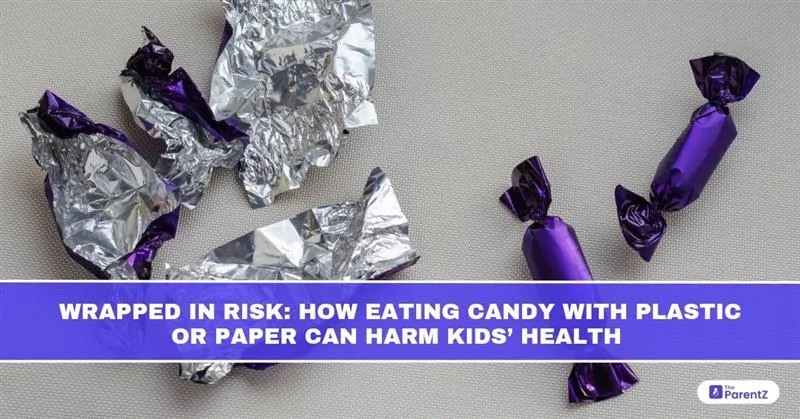A Sticky Situation: The Candy-Wrap Habit
It was a typical birthday party. Balloons bobbed in the breeze, giggles filled the room, and a shower of candies scattered after the piñata burst. In the chaos, little hands scrambled for sweets. One child, too excited to wait, popped the toffee into his mouth, wrapper and all. At first glance, this might have seemed harmless, even amusing. But behind that moment of mischief lies an often-overlooked health hazard.
Across homes, classrooms, and playgrounds, children are seen occasionally consuming candies or chocolates without removing the outer wrapping, be it paper, foil, or plastic. Whether it’s due to distraction, mimicry, or sheer haste, the ingestion of packaging materials, even in small amounts, raises several concerns, particularly in developing bodies.
What Exactly Are Candy Wrappers Made Of?
Commercial candy wrappers are typically made from one or more of the following materials:
- Plastic films (polypropylene or polyethylene)
- Aluminium foil
- Paper, often coated with wax or plastic
- Multi-layer laminates (a mix of plastic, paper, and foil)
These wrappers are designed to resist moisture, prevent contamination, and enhance shelf life. But none of these materials were ever meant to be digested.
According to the Journal of Food Science and Technology, certain food packaging components, especially those involving synthetic materials, may leach harmful substances if ingested. Even though food-grade plastics are designed to be “safe” in contact with food, they are not safe for consumption themselves.
Why Do Kids Ingest Wrappers?
- Accidental Consumption: Particularly among toddlers and preschoolers, wrappers may go unnoticed or be too tightly fused with the candy to peel off.
- Behavioral Imitation: Some children mimic adults who chew gum with foil or watch peers do the same.
- Textural Curiosity: The crinkly, shiny appearance of wrappers may intrigue young minds.
- Lack of Awareness: In many households, the risks of eating food with wrappers are never discussed.
Pediatric nutrition experts from the Indian Pediatrics Journal have emphasized that early eating behaviors are often shaped by environment and education, or the lack thereof.
The Health Hazards Hidden in the Wrappers
1. Digestive Distress
Candy wrappers are non-biodegradable and indigestible. Once swallowed, they can cause:
- Choking or obstruction, especially in smaller children
- Constipation, due to their inability to pass easily through the gut
- Abdominal discomfort, bloating, and indigestion
Case studies in the Archives of Disease in Childhood have reported incidents of bezoar formation (hard masses formed from indigestible materials) when children repeatedly consumed foreign objects like wrappers or foil.
2. Chemical Exposure
Certain wrappers, especially those made from colored plastic or printed paper, may contain:
- Phthalates and BPA, used in plastics and known to disrupt hormonal balance
- Heavy metals like lead or cadmium, especially in low-quality, unregulated packaging
- Dyes and inks, many of which are not intended for food contact
According to the Environmental Health Perspectives journal, chronic exposure to even low levels of these substances can impair neurological development, endocrine function, and gut microbiota, all critical during early childhood.
3. Microbial Contamination
The outer surface of wrappers, having been handled during manufacturing, packaging, and distribution, may carry bacteria or fungi. Once inside the digestive system, these organisms can trigger:
- Stomach infections
- Food poisoning-like symptoms
- Weakened immunity in younger children
In a controlled study cited in the International Journal of Food Microbiology, researchers found microbial contamination on the external surface of candy wrappers, particularly those sold loosely in bulk without hygienic handling.
Silver Foil: Shimmering but Unsafe?
In many parts of India, sweets are wrapped or decorated with a thin layer of silver foil (chandi ka vark). While edible silver is traditionally used in small amounts, concerns have emerged regarding:
- Purity: Cheap or imitation foils may contain aluminium or other toxic metals
- Industrial processing: Often, the foil is produced using animal byproducts or contaminated equipment
- Respiratory and renal strain: When consumed in significant or repeated doses
The Food Safety and Standards Authority of India (FSSAI) has mandated certain purity benchmarks, but these are not always enforced, especially in unbranded or street-sold sweets.
Psychological Patterns: When Habit Becomes Harm
Repeated wrapper consumption, whether out of curiosity, stress, or habit, may point to an underlying condition known as pica. This is a disorder where individuals crave and eat non-food items. Pica is more common in children with nutritional deficiencies or neurodevelopmental conditions.
Pediatricians, as recommended in the Indian Journal of Psychiatry, should screen for behavioral triggers and refer for therapy or nutritional interventions when required.
Prevention: Unwrapping Safety at Home and School
Parents, teachers, and caregivers can take several steps to reduce the likelihood of this habit developing:
- Teach by example: Always unwrap food items fully and discuss the reason.
- Make wrappers “yucky”: Use storytelling to make kids understand that wrappers are not part of the candy.
- Supervise younger children: Especially during festivals or parties, monitor what is being eaten.
- Choose safer brands: Opt for regulated, clearly labeled products with minimal or biodegradable wrapping.
- Pack homemade treats: Reduce dependency on commercial candies by offering homemade sweets without synthetic wrappers.
Many preschools have started using visual cues like posters and puppet shows to teach children the importance of removing wrappers before eating. These small efforts build early habits that last a lifetime.
A Word to Manufacturers
While much of the responsibility lies with adults and educators, manufacturers can contribute by:
- Improving packaging clarity: Using easily peelable, child-safe wrappers
- Avoiding excessive layering, especially those that blend with the candy
- Displaying pictorial warnings for young consumers
The European Food Safety Authority recommends child-friendly packaging standards that are both easy to unwrap and biodegradable, reducing accidental ingestion and environmental waste simultaneously.
Conclusion: Sweetness Shouldn’t Come with a Cost
What starts as an innocent bite can lead to complications if what wraps the candy becomes part of the treat. While most cases of wrapper ingestion pass unnoticed, the risk accumulates over time in the form of toxicity, digestive distress, or harmful habits. By paying attention to what’s going into a child’s mouth, not just the food, but its packaging, caregivers can ensure that the sweetness of childhood remains joyful, not harmful.
In every bite of candy, let safety be the first layer unwrapped.








Be the first one to comment on this story.